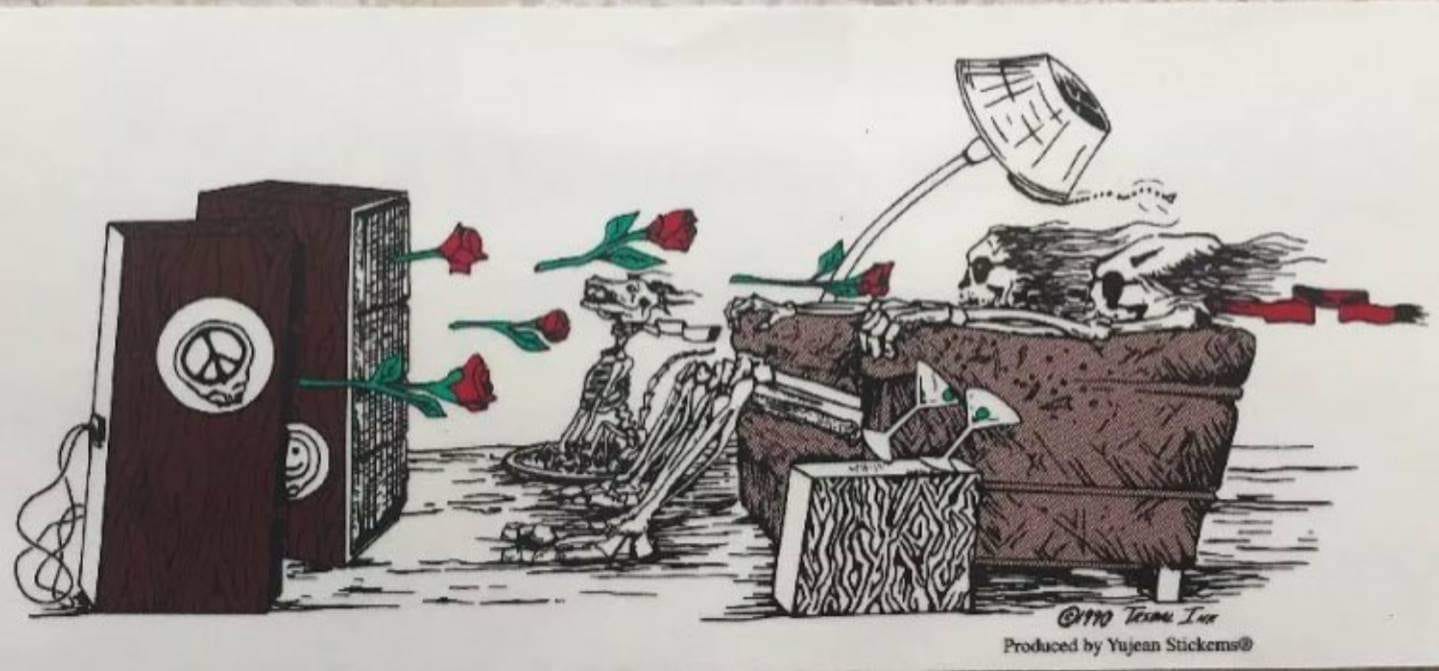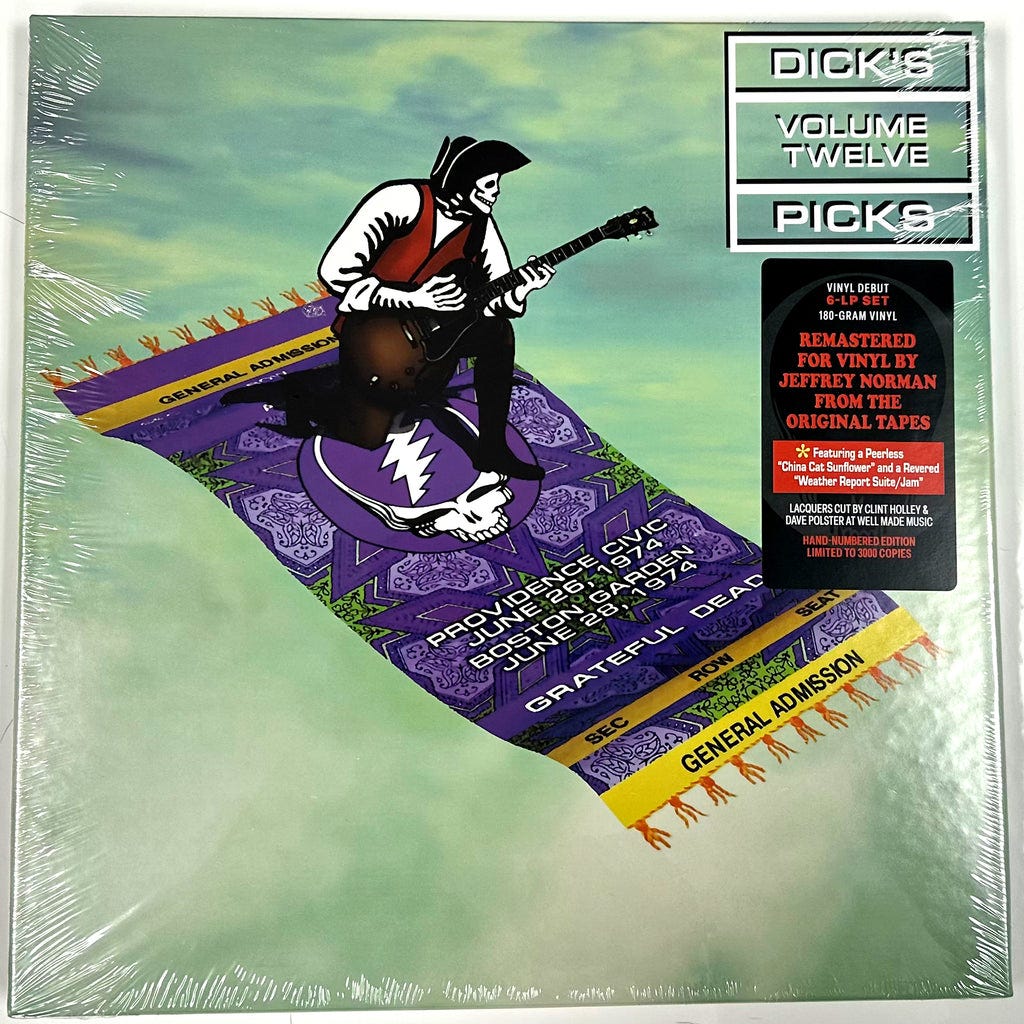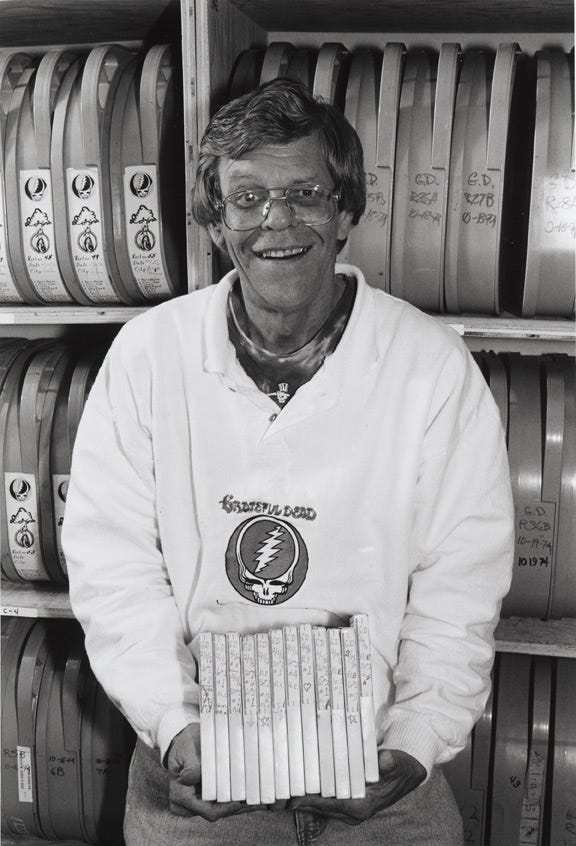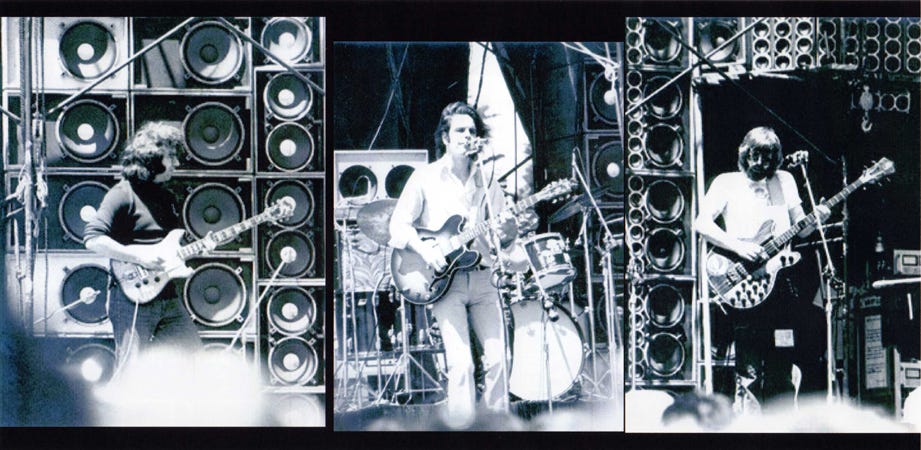Entry Nine - A One Eyed Cheshire: The Grateful Dead, Dicks Picks Volume 12
Tell the folks back home this is the promised land calling
A preamble - the Grateful Dead contain multitudes. As to the political context of the early Grateful Dead leading up to this period, including their relationship with the revolutionary left, please see the previous post on David Crosby’s If I Could Only Remember My Name. As this series, the list I am working from contains a great deal of music either from the Dead or members of the Dead playing with others, it would be downright impossible to capture what they mean, both to the history of cultural production generally, and to myself in particular in one entry. Also see my “Reclaiming the Dead” in Red Wedge, and the entirety of chapter seven in my doctoral dissertation. As to a full-fledged analysis, that will have to wait for one of my books, based on said chapter. In the mean time, this is the first of three entries on Dead albums.
This time, perhaps more than most, it is personal. As this collection of entries is based specifically on what amounted to a list of 100 albums (defined broadly) that informed my taste in music, or as I like to say, my sensibility. With the Grateful Dead, this is tougher, as, well, I’m a Deadhead. And the Dead contain multitudes. When I was in grade 7 , I started seriously listening to the Grateful Dead. It started with listening to my Dad’s Dead records - in particular American Beauty and Europe ‘72, of which there will be entries for both. The Grateful Dead fascinated me as a junior high school kid - the music, the iconography, the culture. Soon I was collecting bootleg cassettes, which is how the Dead maintained their popularity. Way back in the seventies, when corporate record labels cracked down on bootlegging, the Dead did not only tolerate, but encouraged, and as of the mid 80s, officially allowed the taping and free circulation of their concerts.
Getting Dead tapes, before spreadsheets of MP3s, before the internet, for all intents and purposes may have seemed like an effort. One would find classified ads in Grateful Dead/countercultural music magazines, notably Relix, or in annually issued volumes of “Deadbase”. These advertisements really were akin to posts, it was a community developing around trading tapes (EG, you would make them copies of some of your tapes, and they would send you some of theirs). The best people out there, however, were those who accepted “B&P” -blanks and postage, and you’d send them a box of tapes - Maxell XL IIS was the go-to, and then you’d get your tapes. And for recent Grateful Dead - this is circa the late 80s/early 90s, it was not difficult to get one’s hands on a first generation recording. And then of course, there were tapes from various eras of the Dead’s career that would circulate, including soundboard recordings. As the cultural historian Nicholas Merriweather puts it, tape collecting “instilled a sense of historicity in fans”. Periodizing the Dead instinctively placed one in the era in which a show was recorded. This could be that there are sly inside joke references to this or that political phenomenon, or even something as simple as playing the theme for Close Encounters of the Third Kind.
For those unaware, the Grateful Dead as a live band have a number of distinct eras. Like historical materialists and fans of the Star Wars universe, Deadheads have a number of ways of periodizing the Dead. Is it over keyboard players? Improvisational styles? Drugs of choice? Arbitrary periodization with cultural producers tends to obscure more than it clarifies, ignoring the vast distinctions within a given era and commonalities between them. With this being said, for me, both as a young Deadhead and in my late 40s, the period lasting from 1972-1975, in which their improvisation moved beyond psychedelic squonk into a form that has never been replicated, perhaps their most original and sometimes challenging music they ever made. As well, it was an era in which the accumulated and continuing to grow Grateful Dead songbook introduced perhaps the majority of its standards, both original and cover versions. For example, the Dead had been playing the old folk song “I Know You Rider” since the era of the Acid Tests, and in turn, “China Cat Sunflower” had been played since January 1968. And the two songs essentially became one song, “China Cat>Rider” in 1969. Yet it was in this era, among many other songs that this combination achieved utter perfection.

The “China Cat>Rider” on Dick’s Picks 12, from the June 26 1974 Grateful Dead concert in Providence, Rhode Island is ‘worth the price of admission’. Like many versions of this era, there is what is called here “Mud Love Buddy Jam”, presumably a play on “Mind Left Body Jam”, as part of the bridge improvisation between the two songs, but the consensus among Deadheads is that the late Dick Latvala mislabeled what has been commonly known among Deadheads as “Feelin’ Groovy Jam”, as it has a descending chord pattern not unlike the Simon and Garfunkel Song. What makes this more strange is that there actually is an unlabeled approximation of “Mind Left Body Jam” on this record (a 3 CD or 6 LP set bringing together the bulk of the Grateful Dead’s concerts in Providence and Boston, on June 26 and June 28 1974). One knows this is a collection of music for Old heads, when we see that there is not only this iconic jam but also the Ravel-esque “Spanish Jam”, as well as a twenty seven minute piece of free improvisation coming out of “Weather Report suite”. What’s more, we get Phil Lesh and his synth playing pal Ned Lagin doing a mini-set of “Seastones”, Lesh’s electronic side project.
This is challenging Grateful Dead without being scary Grateful Dead. Not all great Grateful Dead is challenging. Perhaps the most beloved shows they ever played were in the spring of 1977, notably the iconic Ithaca show on May 8. Yet these shows are languid, mellow pieces of effervescent improvisation, without so much as challenging you or fucking with your mind. It’s an easy trip, as it were. And then there’s the legendary “Sunshine Daydream” show on Ken Kesey’s farm, on August 27 1972. An all time great, but sometimes very dark, cathartic, not a bad trip as such, but one that crystallizes chaos, something dark - challenging - and scary, albeit somewhat surreal. One notable moment has the band suddenly finding themselves playing Marty Robbins’ country standard “El Paso” in the midst of perhaps the most disturbing “Dark Star” they’d ever played.
The fact that nearly all of the famous Dead shows that circulated when I was growing up trading tapes now have “official releases” from the Grateful Dead’s archives, under the tutelage of its archivist David Lemieux removes a lot of the effort that went into collecting back in the day. But the age of Spotification also allows one, as in the hyperlinks right in this piece of writing, to share the music just like that. Of course the Grateful Dead always put out live albums, indeed, more than most other bands, often simply to fulfill contracts. In 1993, however, Dick Latvala, a lifelong Deadhead who had been working for the Grateful Dead’s ‘offices’ since the 80s, started a unique new venture for the Grateful Dead Family. His job for the Dead had become that of an archivist, and in 1993, through mail order only at first, he started to curate a series of live CD sets of one of his favorite shows. He was a tastemaker. Everyone in the scene took a cue from him as to what was legit good old Grateful Dead, continuing the collection dictated by his sensibilities and notes past his death in 1999. As of now, there is “Dave’s Picks”, curated by current archivist Lemieux.
I never had the tape of 6/28/74, but I had 6/26/74, which makes up the first half of this set, though much of the challenging material is from the 28th. I played the shit out of that tape. It allowed me to escape the doldrums, alienation, and hypermasculinity of high school. If you were a Jewish kid in Toronto in the early 90s, and weren’t stereotypically a jock or a bro or a “J.A.P.” (I can say it, you can’t unless you are a fellow landsman), the Goth or Deadhead landing was not uncommon. I landed in the latter space. I’d chain smoke Du Mauriers (and if I was lucky, perhaps a bit of hash), and just play this over and over again. There just could never be music that even approaches this. The aforementioned “Feeling Groovy” jam I was calling “Uncle John’s Band jam” as it somewhat reminded me of the opening section of that song. But it was the entire suite that just moved me more than anything.
Normally, “China Cat” just appears abruptly, but they work their way into it, with Bob Weir playing just as assertive a role as Jerry Garcia and Phil Lesh. For Weir, particularly in this era, rhythm guitar was a lead instrument. They were not “double lead” guitar like Betts and Allman. Rather, Weir and Garcia had a McCoy Tyner and John Coltrane. They were rhythm and lead insofar as sax would lead and piano would provide rhythm. But Coltrane gave Tyner a lot of space. Coltrane needed Tyner more than Tyner needed Coltrane. For this kind of improvisation, the same could be applied to Garcia/Weir. And Weir’s at his McCoy Tyner best here, playing ‘rhythm’ but absolutely leading this entire suite, from the opening section that would later become the rudiments of his song “Heaven Help the Fool” to a sly extended, rare and somewhat atonal solo leading into Garcia’s solo and finally “Feeling Groovy” entering the picture.
Then we finally get to “Rider”, a standard that the Grateful Dead made their own, to a point that it cover versions of it - such as Stephen Malkmus and the Jicks’ recording of the China>Rider” suite on a Grateful Dead tribute compilation from ten years ago. What is notable here is that one hears how much Malkmus’s squonky and chunky unique guitar style seems almost a carbon copy of 1974 Bob Weir. Weir doesn’t shred, he chops, as it were. Later in the Dead’s career, notably the late 80s and early 90s, he affected an almost shoegaze style in some places, to contrast with the deteriorating Garcia’s MIDI obsession. As to the remainder of the second set of the 6/26/74 show, the tape that I grew up on, which makes up the first CD of this set, when it was released in that format, Weir absolutely leads the band. Of course there’s the standard “Truckin’”, but even more of a rare highlight is Weir’s “Spanish Jam”. Conceived by Weir in 1968, it was largely based on what we may call a “breakbeat” from Miles Davis and Gil Evan’s “Solea”. Phil Lesh wrote, that it was a“a four-bar pattern we’d borrowed from the Miles Davis/Gil Evans album Sketches of Spain.” Deadheads, especially into the late seventies and eighties cultivated “Captain Trips” Garcia as the charismatic leader, something that was quite unhealthy for Garcia and Deadheads alike. At this point in the Dead’s output, there is little doubt that as to the music itself, Weir is the bandleader here.
The second half of the album, from the June 28 1974 concert in Boston is not something I grew up with - by the time the CDs were out, I was 21 with eight years of bootleg collecting accumulated. With this being said, it is every bit as powerful, and works seamlessly with the material from Providence. There are more self-contained songs here, notably dynamite versions of live favorites of the era, “Scarlet Begonias”, “Row Jimmy”, “To Lay Me Down”, among many others. Two tracks, however, drive home the political context that the Dead could not but avoid channeling. This was at a time in which American imperialism was about to lose in Vietnam, the American president was less than two months away from resignation. American capitalism was facing a downturn. Indeed they were at sea on a “Ship of Fools”, singing that old “U.S. Blues”.
These two songs, however cryptic, speak volumes. “U.S. Blues” and its anti-capitalist implications even feature in the Grateful Dead’s advertising copy. Ray Robertson, the author of the liner notes to the reissue of the Dead’s classic album From the Mars Hotel points out that the song, with its pop cultural references and pretty much making fun of the American archetype, “carries an undeniable whiff of late-capitalism ennui…it's the most fun you'll ever have dancing to the end of the American Empire." Yet lyricist Robert Hunter has a warning, Uncle Sam “learned to duck”. The chorus about waving the US flag seems simultaneously about the perhaps ill-conceived hippy/New Left project of reappropriating the stars and stripes. Yet knowing Hunter’s style, it seems far more likely to be an ironic riposte to Uncle Sam. Flag-waving was just another rudimentary activity, like skinning a goat or running someone’s life. But, “nobody noticed that the band’s all packed and gone”. The Dead do thread that Uncle Sam needle quite creatively in this set, denizens of what Greil Marcus calls “the Old Weird America”. Between originals, there are covers of Johnny Cash and Chuck Berry.
“Ship of Fools”, in context is far - less - cryptic. It is a cry of resistance cloaked as a period yarn - to quote a few stanzas -
I won't slave for beggar's pay
Likewise gold and jewels
But I would slave to learn the way
To sink your ship of fools..
Though I could not caution all
I still might warn a few
Don't lend your hand to raise no flag
Atop no ship of fools
No flag-waving here, to say the least. The sinking of a ship of fools, indeed as the encore of the show sends the crowd off in quite a different way than some such wistfulness about palaces or muddy rivers.
The centrepiece of this set, however, is the fifty five minutes of music growing out of Weir’s “Weather Report suite”. of which one half (twenty seven minutes and change) is complete free improvisation, but in a sense that one can hear structure retroactively. While led by Weir at first, Garcia takes over in a tasteful and not at all ostentatious way, and he is at his absolute best making the inhuman seem human. Billy Kreutzman is in his prime here, guiding the overall directionality of this retroactive composition. Starting like something that sounds like a lost Grateful Dead instrumental, the jam goes in multiple directions, from an almost waltz like pattern to a gallop to complete cacophony. It is in parts akin to a synesthetic representation of a swarm of bees. The closing few minutes have the band returning to quick vamping and weaving over a drumbeat from Kreutzman that prefigures thrash or hardcore music. They find a pattern and sort of end up in a loop and then - “US Blues” is vamped on for 3 and a half minutes before Garcia finally comes in with “Red and White” .
Dick’s Picks Volume 12 is everything that is great about the Grateful Dead at the tail end of the period in which they were the cultural vanguard. Summer time had come and gone, my oh my, as it were. The jukebox had been torn down. They were “our” band to the counterculture, and this was almost always imbricated with radical left politics. The Dead began a hiatus from being on the road full time in fall 1974, a few months after this show. They didn’t break up - they even played some shows, and drummer Mickey Hart rejoined the band. Playing a few Bay Area shows in 1975 while mostly focusing on what would become Blues for Allah, they hit the road again in summer 1976, and played steadily until Garcia’s death in 1995. Yet never again were they directly crystalizing a culture of opposition.
This is probably what moved me so much about this era of the Dead when I first starting collecting tapes. There was something vital about this period, starting with the Europe ‘72 tour, which I’ll also be writing about, and ending with the fall 1974 concerts that became The Grateful Dead Movie. As the good guys won abroad, but lost at home, Uncle Sam continued to be the ultimate chameleon. When the Dead came back, they were as good as they ever were. But they had now recruited their base, who would keep growing in much more circuitous and subcultural fashion. When counterculture, a mass phenomena becomes subculture, it is not necessarily a mark of degeneration - for the Dead it gives them resilience. Yet one can’t imagine the early 70s Grateful Dead playing a residency in Vegas or destination shows in Mexico. What a long strange trip.. OK, whatever… Jock-a-mo fee-no ai na-ney! Jock-a-mo fee na-ey!






